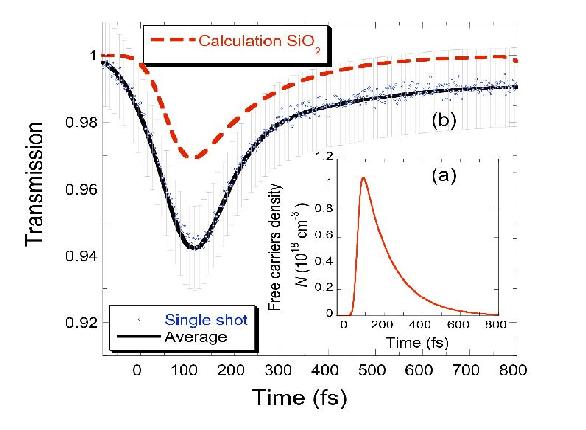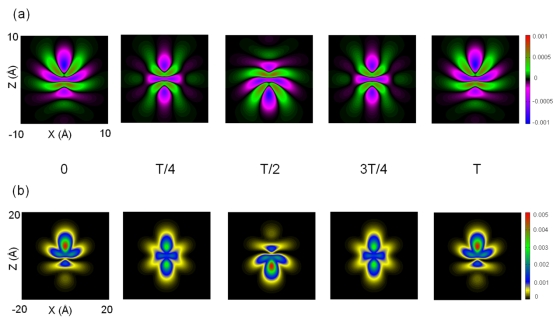News archive from 2011 to 2015
Time-resolved observation of band gap shrinking and electron-lattice thermalization in x-ray excited GaAs
11 December 2015
The paper titled "Time-resolved observation of band-gap shrinking and electron-lattice thermalization within X-ray excited gallium arsenide" by Beata Ziaja, Nikita Medvedev, Victor Tkachenko, Theophilos Maltezopoulos, and Wilfried Wurth, published on-line on Dec. 11, 2015 in Nature's Scientific Reports, proposes a new method for measuring the rate of energy exchange between excited electrons and atomic lattice in laser-excited semiconductors.
Ultrafast charge transfer of a valence double hole in glycine driven exclusively by nuclear motion
02 October 2015
Atomic motion can drive charge transfer on unexpectedly short time scales. When the electron cloud of a molecule is hit by an ultrashort burst of light, complex processes ensue. One or more of the very light and fast electrons can suddenly be kicked out, forcing the other electrons to quickly relocate on time scales as short as just a few femtoseconds (1 fs = 0.000000000000001 s). Only at much longer times do the heavier atomic nuclei respond and play a role in the redistribution of electrical charge.
Sensitivity of nonlinear photoionization to resonance substructure in collective excitation
09 April 2015
The year 2014 marked the 50th anniversary of the discovery of the 4d giant dipole resonance in atomic xenon (nuclear charge Z=54). The three outermost electron shells of xenon (from outside to inside) are 5p, 5s, and 4d.
Ionization potential depression in dense plasmas
08 July 2014
The dense plasma state is a common phase of matter in the universe. It can be found in stars and giant planets, and is created during fusion experiments. The electronic structure of an atom embedded in a dense plasma differs significantly from that of an isolated atom.
Ultrafast energy transfer to liquid water by sub-picosecond high-intensity terahertz pulses: An ab initio molecular dynamics study
23 October 2013
Liquid water is the most common environment for chemical and biological processes. Most of them occur as a consequence of thermal random fluctuations of the environment, which every once in a while create the conditions for a chemical reaction to occur. Therefore, bringing a large amount of energy to liquid water in a as short as possible time can open new avenues for the controlled exploration of thermally activated chemical reactions in liquids.
Ultrafast free-carrier generation in optically transparent materials
17 February 2013
Recently, few-femtosecond pulses have become available at hard X-ray free electron lasers. Coupled with available sub-10 fs optical pulses, investigations into few-femtosecond dynamics are not far off. However, sufficient synchronization between optical lasers and X-ray pulses continues to be challenging.
Nonthermal phase transitions in semiconductors induced by a femtosecond extreme ultraviolet laser pulse
22 January 2013
In that paper, we presented a novel theoretical approach, which allowed the study of nonequilibrium dynamics of both electrons and atoms/ions within free-electron laser excited semiconductors at femtosecond time scales.
Electrons snapped by X-rays
26 March 2013
Electrons are the glue that keeps atoms in matter together, and their motion plays a key role in the function and transformation of materials. During complex chemical and biological reactions, electrons undergo ultrafast rearrangements, determining the later properties of the generated substance or material.
Electron holes on the move
15 January 2013
Electron-electron correlation plays a fundamental role in the understanding of the electronic structure of molecules and materials. In systems with strong correlation, a simple description of each electron as moving in an average potential generated by the other electrons fails. In this work, we find evidence for strong correlation between an electron hole and a proton.
Imaging electronic quantum motion with light
17 July 2012
X-rays are used to probe the atomic-level structure of complex molecules, and methods for that tasks have been developed to more and more perfection, for instance at light sources like the PETRA III storage ring at DESY. But the images generated to date have been static: pictures resolve situations in real-space, but not real-time.Free-electron lasers, a new generation of X-ray sources providing unprecedented intensity in very short light pulses, promise to solve the problem in near future, opening up whole new world of exploring matter in action.
A lifetime for ionized acetylene
20 December 2011
Photoisomerization, the process by which the absorption of a photon induces geometrical rearrangements of the atoms in a molecule, is an important phenomenon in chemistry and biology. It is, for example, responsible for initiating the cascade of events underlying the process of vision, where photons interact with retinal molecules in the eye.
Unexpected decoherence in ultrafast photoionization
02 February 2011
Attosecond science holds the promise of controlling electron motion to manipulate physical processes at the atomic level. One way of inducing electron motion is photoionization using an attosecond laser pulse. The focus of our recent paper was to answer an open fundamental question about electron control via attosecond photoionization: Can the nonstationary state of the parent ion be described by a Schrödinger wave function, i.e., is the state coherent?











